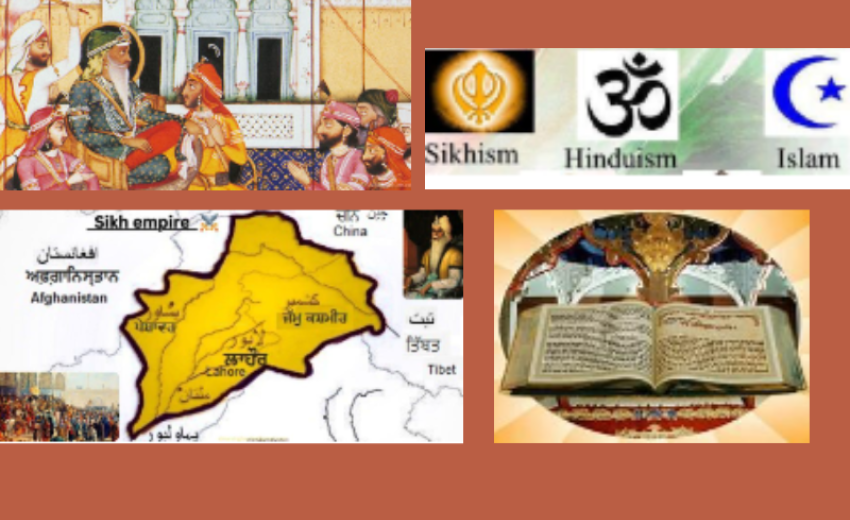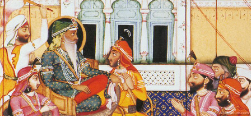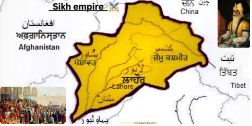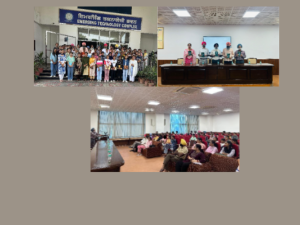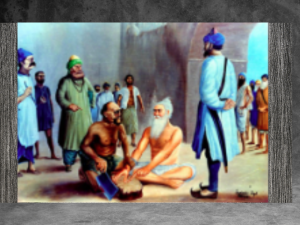[In July 2024, Machintos Dillon, a Student of BA (Religious Studies) at Sheffield University, UK, contacted Dr. Devinder Pal Singh, Director of the Center for Understanding Sikhism, Mississauga, ON, Canada, to explore the various aspects of Sikh history and Sikhism. This interaction resulted in the following deliberation.]
Dillon: What distinguished Sikhism from the two dominant faiths, Hinduism and Islam, at the time of its birth?
Dr. Singh: At the time of its birth in the late 15th century, Sikhism distinguished itself from the dominant faiths of Hinduism and Islam in several major ways:
- Strict Monotheism: Sikhism was founded on the belief in one, formless God (Ik Oankar), who is eternal and omnipresent. Guru Nanak strongly emphasized this belief in a single, universal God. Hinduism is predominantly polytheistic, worshiping multiple deities. While some sects and philosophies within Hinduism advocate for a monotheistic approach (like Advaita Vedanta), the general practice was and is polytheistic. Islam is strictly monotheistic, believing in one God (Allah). The concept of monotheism was already well-established and central in Islam.
- Rejection of Rituals and Idolatry: Guru Nanak, the founder of Sikhism, rejected the prevalent elaborate rituals and idolatry common in both Hinduism and Islam (e.g grave worship). He emphasized inner devotion and remembering God's name over external religious practices. On the other hand, Hinduism involved various rituals, ceremonies, and idol worship, which were integral parts of religious life. Islam prohibited idolatry and emphasized a set of rituals (such as the five daily prayers) as acts of worship.
- Social and Religious Equality: Sikhism strongly advocates for the equality of all humans, regardless of caste, creed, or gender. Guru Nanak denounced the caste system and preached that all people are equal in the eyes of God. Hinduism is deeply entrenched in the caste system, which dictates social hierarchy and roles. Social mobility was limited, and discrimination based on caste was prevalent. Islam preached the equality of all Muslims before God, but in practice, social hierarchies and tribal affiliations influenced social structure.
- Guru and Scripture: In Sikhism, Guru Nanak was the first of ten Sikh Gurus who were seen as spiritual leaders and guides. The teachings of the Gurus were recorded and became a part of the Guru Granth Sahib, the central religious scripture. Hinduism has no single founder or central religious authority. Instead, it developed over thousands of years with contributions from numerous sages and saints. Islam was founded by Prophet Muhammad, who is considered the last prophet in a long line of prophets. The Quran is the central religious text, considered the literal word of God as revealed to Muhammad.
- Inclusivity and Community Service: Sikhism Emphasizes community service (Seva) and inclusivity. The concept of Langar (community kitchen) was established to ensure that everyone, regardless of background, could share a meal together. In Hinduism social and religious practices often reinforced caste distinctions. Though charity and service were encouraged, they were generally within the confines of one's own community or caste. In Islam, charity (Zakat) is one of the Five Pillars, but social practices vary widely across different regions and cultures.
- Gender Equality: In Sikhism, Guru Nanak and subsequent Gurus promoted the idea that men and women are equal in God's eyes. Women were encouraged to participate in all aspects of religious and social life. In Hinduism, women’s roles were often defined by traditional and patriarchal norms, though there were variations across regions and sects. In Islam, the Quran promoted certain rights for women, but cultural practices often influenced the actual status of women, leading to varied interpretations and implementations.
- Synthesis and Reform: Sikhism sought to create a synthesis of spiritual ideas and social reforms. Guru Nanak’s teachings incorporated elements of both Hindu and Islamic mysticism but presented them in a new, reformist light. Hinduism absorbed and adapted a multitude of philosophical and religious ideas over centuries. Islam maintained a distinct religious identity with a clear set of beliefs and practices, as revealed in the Quran and Hadith.
In a nutshell, Sikhism distinguished itself at its birth through a strict monotheistic belief, rejection of rituals and caste distinctions, emphasis on equality and community service, gender equality, and the leadership of the Gurus. These principles set it apart from the existing religious practices of Hinduism and Islam in 15th-century India.
Dillon: What distinguishes Sikhism from the two dominant faiths, Hinduism and Islam, from its birth to date?
Dr. Singh: Sikhism, founded in the late 15th century by Guru Nanak in the Punjab region of South Asia, is distinct from Hinduism and Islam in several main ways:
Evolution and Historical Context
Historical Development: Sikhism emerged in 15th-century India, a time of social and religious upheaval. It developed a unique identity, especially during the Mughal period when Sikh Gurus faced persecution. Hinduism evolved over thousands of years, incorporating diverse beliefs and practices. It absorbed and adapted to various cultural influences. Islam began in 7th-century Arabia and rapidly expanded through conquests and conversions, influencing various cultures and societies.
Foundational Beliefs and Origins
- Monotheism: Sikhism emphasizes strict monotheism, the belief in one God (Ik Oankar), who is formless, eternal, and omnipresent. Hinduism is polytheistic, believing in a vast pantheon of gods and goddesses, though it also includes monotheistic and henotheistic traditions. Islam is strictly monotheistic, worshipping one God (Allah), who is singular and formless.
- Scriptures: The primary scripture of Sikhism is the Guru Granth Sahib, which is considered the eternal Guru. It contains writings by Sikh Gurus and other saints. Hinduism has many scriptures, including the Vedas, Upanishads, Bhagavad Gita, Ramayana, and Mahabharata. The Quran is the central religious text of Islam. It is believed to be the word of God as revealed to Prophet Muhammad. The Hadiths are also significant.
- Prophets and Gurus: Sikhism was founded by Guru Nanak, followed by nine successive Gurus. The Guru Granth Sahib is considered the eternal Guru after Guru Gobind Singh. Hinduism has no single founder or prophet. It evolved over millennia with contributions from various sages, saints, and philosophers. Islam was founded by Prophet Muhammad, who is considered the last prophet in a long line of prophets.
Practices and Rituals
- Worship and Rituals: Sikhism emphasizes meditation on God's name (Naam Japna), community service (Seva), and living a truthful, honest life. Rejects rituals and idol worship. Hinduism includes a variety of rituals, ceremonies, and worship practices, often involving idols and images of gods. Islam practices include the Five Pillars: Shahada (faith), Salah (prayer), Zakat (charity), Sawm (fasting), and Hajj (pilgrimage). Idolatry is strictly prohibited.
- Equality and Social Justice: Sikhism strongly emphasizes equality and social justice. Rejects caste distinctions and promotes gender equality. Historically, the caste system has been a significant aspect of Hinduism, though modern Hinduism is evolving to challenge and change these practices. Islam stresses equality before God, though cultural practices related to gender and social roles can vary widely.
Symbols and Identity
- Distinctive Symbols: Sikhism has Ik Oankar and Khanda, The Five Ks (Kesh, Kara, Kanga, Kachera, and Kirpan) are articles of faith worn by initiated Sikhs (Khalsa). Hinduism has diverse symbols such as Om, Swastika, and various deities’ symbols. In Islam, no specific religious symbols are mandated, but the crescent moon and star are often associated with the faith.
- Community and Institutions: In Sikhism, the Gurdwara (Sikh temple) is the central place of worship and community gathering. The Langar (community kitchen) symbolizes the importance of equality and sharing. In Hinduism, temples are places of worship with various community and spiritual functions. In Islam, the Mosque is the central place of worship and community activity.
Modern Context
Global Presence: Sikhism has a significant global diaspora, particularly in Canada, the UK, and the USA. It remains closely tied to its Punjabi roots. Hinduism also has a widespread diaspora, particularly in countries like the USA, UK, Canada, and Australia. Islam is one of the largest religions worldwide, with a presence on every continent.
In a nutshell, Sikhism distinguishes itself from Hinduism and Islam through its unique combination of monotheism, rejection of ritualism, emphasis on equality and social justice, and specific practices and symbols that define its followers' daily lives and communal identity.
Dillon: As Guru Granth has hymns from both Muslim and Hindu mystics, did Guru Nanak adopt or incorporate aspects of Hinduism or Sufism in his teachings?
Dr. Singh: Yes, Guru Nanak, the founder of Sikhism, incorporated some aspects of Hinduism and Sufism into his teachings. His approach was eclectic and aimed at transcending the religious boundaries of his time to convey a universal message of devotion to one God, equality, and righteous living. Here are some main ways in which Guru Nanak adopted and integrated elements from both traditions:
Incorporation of Hindu and Sufi Elements
- Devotional Mysticism: In Hinduism, the Bhakti (devotional) movement, which emphasized a personal and direct relationship with God through love and devotion, was influential during Guru Nanak’s time. Guru Nanak adopted the language and fervor of Bhakti poetry to express devotion to a single God. Sufism, the mystical branch of Islam, focuses on a personal connection with God, often through love, devotion, and the remembrance of God’s name (Dhikr). Guru Nanak’s emphasis on meditation and chanting God’s name (Naam Japna) reflects Sufi practices.
- Unity and Oneness of God: Certain sects and philosophical schools within Hinduism, like Advaita Vedanta, advocate for the oneness of God and the unity of all existence. Guru Nanak’s teachings often echo the concept of a singular, formless God that is beyond human comprehension. Sufism stresses the oneness of God (Tawhid) and the belief that God is immanent in all aspects of life. Guru Nanak’s emphasis on the omnipresence and omnipotence of God aligns with Sufi teachings.
- Rejection of Rituals and Formalism: Guru Nanak critiqued Hinduism's ritualistic and caste-bound practices, advocating instead for sincere devotion and ethical living. Sufi mystics often rejected the formalism and orthodoxy of institutionalized religion, focusing on internal spirituality. Guru Nanak’s disdain for empty rituals and external shows of piety mirror this Sufi attitude.
- Ethical and Moral Conduct: Teachings from the Bhagavad Gita and other Hindu texts emphasize righteous living (Dharma) and selfless action. Guru Nanak incorporated similar ideas, emphasizing honest living, social justice, and selfless service (Seva). Sufi teachings often stress moral purity, compassion, and service to humanity. Guru Nanak’s messages about treating everyone equally and engaging in selfless service reflect these Sufi values.
- Hymns in Guru Granth Sahib: The Guru Granth Sahib, the central scripture of Sikhism, includes hymns from a diverse group of saints and mystics, including both Hindu and Muslim figures: Hindu Bhakti Saints like Kabir, Namdev, Ravidas, and others, whose hymns are included in the Guru Granth Sahib, were critical of the caste system and emphasized a direct relationship with God. Muslim Sufi poets like Baba Farid and Bhagat Bhikhan, whose hymns are also featured in the Guru Granth Sahib, stressed the love of God, humility, and the importance of inner spiritual life over external rituals.
- Synthesis of Ideas Guru Nanak’s teachings represent a synthesis of the spiritual ideas prevalent in his time, drawing from both Hindu and Sufi traditions. By incorporating hymns from both Hindu and Muslim mystics, Guru Nanak emphasized the universal nature of his message, transcending religious and sectarian boundaries. He sought common ground between the two dominant religions of his time, advocating for the unity of humanity under one God. While drawing from these traditions, Guru Nanak’s teachings were original in their formulation, emphasizing a path of spirituality that was accessible to all, regardless of caste, creed, or gender.
In summary, Guru Nanak’s teachings incorporate and adapt elements from Hinduism and Sufism. His approach highlights the universal aspects of spirituality, ethical living, and devotion to one God, creating a new, inclusive path that addresses his time's social and spiritual needs.
Dillon: Is Sikhism only a spiritual creed or religious order?
Dr. Singh: Sikhism is both a spiritual creed and a religious order, encompassing a comprehensive way of life that integrates spiritual, ethical, and social dimensions. It is not limited to spiritual or religious beliefs alone but extends to a holistic approach to living. Here are the various aspects that illustrate the multifaceted nature of Sikhism:
- Spiritual and Religious Aspects: Sikhism emphasizes devotion to a single, formless God (Ik Oankar) and teaches that God is omnipresent, omnipotent, and beyond human comprehension. The Guru Granth Sahib is the central religious scripture, containing hymns and writings by Sikh Gurus and other saints, which guide the spiritual and moral lives of Sikhs. The ten Sikh Gurus provided spiritual leadership and teachings, culminating in the Guru Granth Sahib, which is regarded as the eternal Guru. Sikhs engage in daily prayers (Nitnem), meditation on God’s name (Naam Japna), and participate in congregational worship (Sangat) in Gurdwaras.
- Ethical and Moral Aspects: Sikhs are encouraged to live honest and truthful lives and earn their livelihood through hard work (Kirat Karni). Sikhism strongly advocates for the equality of all humans, rejecting caste distinctions and promoting gender equality and social justice. Selfless service (Seva) is a core principle that encourages Sikhs to contribute to the welfare of others and the community.
- Social and Communal Aspects: The concept of Sangat (community) is vital, where Sikhs come together to worship and support one another, fostering a sense of brotherhood and unity. Langar's practice, where free meals are served to all regardless of background, exemplifies the principles of equality and community service. Sikhs celebrate various religious festivals, such as Vaisakhi, Gurpurabs (Guru's birth anniversaries), and Diwali, reinforcing community bonds and religious devotion.
- Political and Social Activism: Sikh history includes significant political and military involvement, particularly during periods of persecution, such as the Mughal era. The Khalsa, established by Guru Gobind Singh, was both a spiritual and military order to protect the faith and ensure justice. Sikhs continue to engage in social and political activism, advocating for human rights, justice, and community welfare worldwide.
- Cultural and Daily Life: Sikhism has been influenced by Punjabi culture, which is reflected in music (Kirtan), art, and language. Initiated Sikhs (Khalsa) observe the Five Ks (Kesh, Kara, Kanga, Kachera, Kirpan), which are physical symbols of their faith and commitment to Sikh principles. Sikh teachings emphasize family values, ethical conduct, and contributing positively to society.
So, Sikhism is a comprehensive way of life encompassing spiritual, ethical, social, and cultural dimensions. It is not just a set of religious beliefs but a holistic framework that guides adherents in all aspects of their lives, promoting a balance between spiritual devotion, moral integrity, and social responsibility.
Dillon: Does Sikhism lack a social, economic and political order, as these are not codified in any Sikh scriptures?
Dr. Singh: While Sikhism may not have a detailed, codified social, economic, and political order outlined in its scriptures, it nonetheless provides guiding principles that influence these aspects of life. The teachings of the Sikh Gurus and the values enshrined in Sikh scripture lay a strong foundation for ethical conduct, social justice, and community-oriented living, which naturally extend to social, economic, and political spheres. Here’s how Sikhism addresses these areas:
Social Order
- Equality and Justice: Sikhism strongly advocates for the equality of all individuals, regardless of caste, creed, gender, or social status. This principle is derived from the teachings of Guru Nanak and subsequent Gurus, who denounced the caste system and emphasized the universal brotherhood of humanity. The practice of Langar (community kitchen) symbolizes and reinforces social equality, as people from all walks of life eat together.
- Community and Service: The concept of Sangat (congregation) emphasizes the importance of community life and mutual support. Seva (selfless service) is a core principle, encouraging Sikhs to engage in charitable activities and serve society without any expectation of reward.
Economic Order
- Honest Living: Sikhs are encouraged to earn their livelihood through honest means (Kirat Karni). This principle promotes economic integrity and discourages exploitation and corruption.
- Sharing and Welfare: Vand Chakna (sharing with others) is another key principle. Sikhs are taught to share their earnings with those in need, ensuring a fairer distribution of resources. Community-oriented practices such as Langar and various charitable activities reflect an economic ethos centred around generosity and welfare.
Political Order
- Resistance to Oppression: Sikh history has examples of standing up against injustice and tyranny. The Khalsa, established by Guru Gobind Singh, was both a spiritual and military order dedicated to protecting the faith and defending the oppressed.
- Miri-Piri Doctrine: Guru Hargobind established the doctrine of Miri-Piri, which signifies the dual responsibility of temporal (political) and spiritual leadership. This concept underscores the idea that spiritual leaders also have a role in ensuring justice and good governance in society.
- Democratic Principles: Sikh governance principles reflect democratic values, as seen in the tradition of decision-making through consensus in the Guru’s times, Panj Payara tradition, and the practice of Sarbat Khalsa, a biannual assembly of the Sikh community for collective decision-making.
Scriptural Guidance and Interpretations
- Ethical Guidelines: The Guru Granth Sahib, while primarily a spiritual text, contains teachings that promote ethical behaviour, justice, and social responsibility. These teachings can be applied to social, economic, and political contexts.
- Role of Rehat Maryada: The Sikh Rehat Maryada, a code of conduct compiled from the teachings of the Gurus and the Sikh community’s traditions, provides additional guidance on ethical and social behaviour, influencing how Sikhs interact with broader societal systems.
Modern Engagement
- Human Rights and Activism: Sikh teachings inspire involvement in social justice, human rights, and political activism. Sikhs have historically been involved in movements for independence, justice, and social reforms.
- Economic Participation: Sikhs are active in various economic sectors, often applying the principles of honesty, hard work, and sharing to their professional lives.
- Political Involvement: Sikhs participate in political systems worldwide, advocating for policies that align with their values of equality, justice, and community welfare.
In conclusion, while Sikhism may not provide a detailed, codified social, economic, and political order in its scriptures, the principles and teachings of the Gurus offer a robust framework for ethical conduct in all areas of life. These principles have been practically applied throughout Sikh history and continue to guide them in their social, economic, and political engagements.
Dillon: Do Sikh scholars author any texts on social, economic and political order from a Sikh viewpoint?
Dr. Singh: Yes, Sikh scholars have authored numerous texts on social, economic, and political order from a Sikh viewpoint. Sikhism, with its origins in the late 15th century in the Punjab region of South Asia, incorporates teachings that address various aspects of social justice, equality, and governance. Here are a few main themes and scholars:
Main Themes in Sikh Thought on Social, Economic, and Political Order
- Equality and Social Justice: Sikhism advocates for equality among all humans, regardless of caste, creed, or gender. This is exemplified by the institution of Langar (community kitchen) where everyone sits together and eats regardless of social status.
- Economic Justice: The concept of Dasvandh (donation of one-tenth of one's earnings) encourages Sikhs to share their wealth with the community and those in need. Seva (selfless service) is emphasized as a means to support the community and uphold economic justice.
- Political Sovereignty: Sikh history includes the establishment of the Khalsa by Guru Gobind Singh, which emphasized self-governance and resistance against oppression. The concept of Miri-Piri (temporal and spiritual authority) underlines the integration of spiritual and political life.
Prominent Sikh Scholars and Their Contributions
- Bhai Gurdas (1551-1637): An early Sikh scholar, Bhai Gurdas's writings provide significant insight into the teachings of the Sikh Gurus and the socio-political context of their times.
- Sirdar Kapur Singh (1909-1986): A prominent Sikh philosopher and politician, his works, such as "Parasharprasna" and "Sikhism for Modern Man," explore Sikh perspectives on politics, governance, and social order.
- Daljeet Singh: He is known for his works on Sikh philosophy and history, including "The Sikh Ideology” and "Essentials of Sikhism." He provides a detailed analysis of Sikh thought in relation to modern political concepts.
- Dr. Kharak Singh: Founder of the Institute of Sikh Studies, he has written extensively on the application of Sikh principles in contemporary social and economic issues.
- Dr. Harjinder Singh Dilgeer: A prolific writer on Sikh history, culture, and politics. His works, such as "The Sikh Reference Book" and " Sikh History 1469 To 1708," offer insights into the Sikh viewpoint on various socio-political issues.
Books by Sikh Scholars
- "Guru Granth Sahib: An Analytical Study" by Surinder Singh Kohli
This book offers a comprehensive analysis of the teachings of Guru Granth Sahib, including its perspectives on social justice, equality, and governance.
- "Sikhism and Civilization" by Daljeet Singh
This work explores the intersection of Sikh teachings and political thought, discussing the historical and contemporary relevance of Sikh principles in politics.
- "Sikh Ideology, Polity and Social Order" by J S Grewal
The book provides insights into Sikh ideology and its application to social and political order, focusing on the contributions of the Sikh Gurus.
- "The Sikh Vision of Heroic Life and Death" by Nirbhai Singh
This book discusses the Sikh perspective on life, death, and the concept of martyrdom, linking these ideas to broader social and political contexts.
- "Sikhism and the Indian Society" by W. H. McLeod
While written by a non-Sikh scholar, McLeod's work is highly regarded for its in-depth study of Sikh society, including its social, economic, and political dimensions.
- "The Concept of Man in Sikhism" by Lajwanti Lahori
This book delves into the Sikh understanding of human nature and its implications for social and political thought.
- "The Sikh Rebellion and the Hindu Concept of Man" by Cynthia Keppley Mahmood
A study of the Sikh resistance movement and its ideological foundations in contrast to Hindu socio-political concepts.
- "The Sikhs: Ideology, Institutions, and Identity” by J. S. Grewal
This book overviews Sikh ideals and their practical application in societal institutions, including political structures.
- "Ethics and Business: Evidence from Sikh Religion" by Charan Singh
Analyzes how Sikh ethical teachings intersect with economic practices and the spirit of enterprise.
- "Sikhs in History" by Sangat Singh
A comprehensive history of the Sikhs, with emphasis on their socio-political evolution and contributions.
- "Religion and Politics in Sikhism: The Khalsa Perspective" by Tarlochan Singh Nahal
This book explores the relationship between religion and politics in Sikhism, particularly through the lens of the Khalsa tradition.
- "Punjab: A History from Aurangzeb to Mountbatten" by Rajmohan Gandhi
While not exclusively about Sikhism, this book provides a detailed historical context that includes the socio-political role of Sikhs in Punjab.
- "The Sikh Diaspora: The Search for Statehood" by Darsham Singh Tatla
Examines the political aspirations and activities of the Sikh diaspora, with insights into their socio-political engagement.
Academic Journals, Articles and Contemporary Discussions
In addition to historical texts, contemporary Sikh scholars and institutions continue to address social, economic, and political issues. Journals like "The Sikh Review," “Journal of Studies in Sikhism and Comparative Religion,” “The Sikh Research Journal,” “Journal of Understanding Sikhism,” "The Journal of Sikh Studies," “The Sikh Bulletin,” and "Abstracts of Sikh Studies" publish articles that delve into current issues through the lens of Sikh philosophy and teachings. These works collectively contribute to a rich body of literature that reflects the Sikh perspective on social, economic, and political order.
Dillon: Did the Khalsa Raj, which was in existence for about 60 years in India, have a distinct and parallel legal system, polity, economic and fiscal order etc.?
Dr. Singh: Yes, the Khalsa Raj, particularly under the rule of Maharaja Ranjit Singh (1799-1839), had distinct legal, political, economic, and fiscal systems that were influenced by Sikh doctrines and values.
Legal System
- Adalat Courts: Maharaja Ranjit Singh established a system of courts known as Adalats, which was responsible for civil and criminal cases. The legal system was based on traditional Sikh principles, Islamic law (Sharia), and local customs.
- Panchayati System: Village-level disputes were often resolved through the Panchayati system, a traditional method where a council of elders would adjudicate matters. This system emphasized community-based decision-making, reflecting the Sikh principles of fairness and justice.
- Equality Before Law: Sikh doctrines of equality influenced the legal system, ensuring that all subjects, regardless of religion or social status, were treated equally under the law.
Political System
- Sovereignty and Governance: The Khalsa Raj was characterized by a centralized form of governance with Maharaja Ranjit Singh as the sovereign. He maintained a well-organized administrative structure with various departments overseeing different aspects of governance.
- Integration of Miri-Piri: The concept of Miri-Piri (temporal and spiritual authority) was reflected in the governance, blending religious values with political administration. The state was secular in practice, providing freedom of religion and ensuring that governance was inclusive of all communities.
- Merit-Based Administration: The administration was largely merit-based, with appointments based on ability rather than birthright. This reflected the Sikh emphasis on merit and capability.
Economic and Fiscal Order
- Land Revenue System: The Khalsa Raj implemented an efficient land revenue system, with assessments based on the fertility and productivity of the land. Revenue collection was fair and systematic, providing stability and prosperity in the region.
- Trade and Commerce: The state encouraged trade and commerce, developing infrastructure such as roads and markets. Sikh doctrines of honest living and fair trade influenced economic policies, promoting ethical business practices.
- Public Welfare: The government invested in public welfare projects, including the construction of hospitals, schools, and irrigation systems. This reflected the Sikh principle of Seva (selfless service) and the responsibility of the state to ensure the well-being of its subjects.
- Taxation Policies: Taxation was structured to be equitable, avoiding excessive burdens on the poor. Taxes were levied on agricultural produce, trade, and certain goods, but the policies were designed to be fair and supportive of economic growth.
Military System
- Khalsa Army: The Khalsa Army was a formidable force organized on principles of discipline, merit, and loyalty. It included soldiers from various communities, reflecting the inclusive nature of the Khalsa Raj.
- Modernization: Maharaja Ranjit Singh modernized the army by incorporating European training and tactics, which enhanced its effectiveness and efficiency.
Thus the Khalsa Raj under Maharaja Ranjit Singh was notable for its distinctive and parallel systems influenced by Sikh doctrines. The legal, political, economic, and military systems were structured to reflect Sikh values of justice, equality, meritocracy, and public welfare. This period is often remembered as a golden era of Sikh rule, characterized by prosperity, stability, and progressive governance. Here are some references that provide detailed information about the Khalsa Raj, its systems, and its influence from Sikh doctrines:
Books
- "Ranjit Singh: Maharajah of the Punjab" by Khushwant Singh. This biography provides an in-depth look at Maharaja Ranjit Singh's rule, including his legal, political, economic, and military systems.
- "The Sikh Empire (1799-1849)" by J. S. Grewal explores the structure and functioning of the Sikh Empire, covering its administration, legal systems, and fiscal policies.
- "Empire of the Sikhs: The Life and Times of Maharaja Ranjit Singh" by Patwant Singh and Jyoti M. Rai is a comprehensive account of the Sikh Empire under Ranjit Singh, detailing the governance, military, and economic strategies.
- "A History of the Sikhs: Volume 1: 1469-1839" by Khushwant Singh. It provides a historical context and details about the Khalsa Raj's governance, including its legal and fiscal policies.
- "The Sikh Religion, Vol. 1-6: Its Gurus, Sacred Writings and Authors" by Max Arthur Macauliffe. These volumes provide detailed insights into Sikh doctrines and how they influenced the governance and social systems of the Sikh Empire.
- “Origin of the Sikh power in the Punjab and political life of Maharaja Ranjit Singh, with an account of the religion, laws, and customs of Sikhs” by Prinsep, Henry Thoby, 1793-1878
Academic Articles
- "The Administration of Justice in the Kingdom of Lahore: 1799-1849" by J. S. Grewal
This article, published in The Journal of Asian Studies, discusses the legal systems under Maharaja Ranjit Singh’s rule.
- "The Land Revenue System of Maharaja Ranjit Singh" by Kirpal Singh
Published in The Panjab Past and Present, this article examines the economic policies and land revenue system of the Sikh Empire.
- "Military Organization under Maharaja Ranjit Singh" by G. L. Chopra
An analysis of the military strategies and modernization efforts during Ranjit Singh’s reign, published in various historical journals.
Other Sources: "The Sikh Review": This journal frequently publishes articles on Sikh history, including the socio-political and economic aspects of the Khalsa Raj. "Abstracts of Sikh Studies" is another journal that offers detailed analyses of various aspects of Sikh governance and its underlying doctrines. These references will provide you with a comprehensive understanding of the Khalsa Raj's legal, political, economic, and fiscal systems, as well as the influence of Sikh doctrines on these structures.
Dillon: Is there any legal system at all in Sikhism?
Dr. Singh: Sikhism, as a religion, does not prescribe a formal legal system in the same way that some other religions, such as Islam, have Sharia law. However, Sikh teachings do encompass principles of justice, fairness, and social order that have historically influenced legal and social practices within Sikh communities. These principles can be found in the Guru Granth Sahib, the central religious scripture of Sikhism, and in the Rehat Maryada, which is the code of conduct for Sikhs.
Main Principles Influencing Legal Practices in Sikhism
- Equality and Justice: Sikhism emphasizes the equality of all human beings. This is reflected in the teachings of Guru Nanak and subsequent Gurus, who advocated for the fair and equal treatment of all individuals, regardless of caste, creed, gender, or social status.
- Honesty and Integrity: Sikhs are encouraged to live truthfully and conduct themselves honestly. The principle of Kirat Karni (honest living) underlines the importance of earning a livelihood through honest means and ethical behaviour.
- Compassion and Forgiveness: Compassion and forgiveness are important values in Sikhism. Sikhs are taught to be compassionate and forgiving towards others, aligning with the broader principle of Seva (selfless service).
- Community and Collective Decision-Making: The concept of Panj Piare (the Five Beloved Ones) embodies the idea of collective leadership and decision-making. Historically, Sikh communities have used a system of councils or assemblies (Sikh Sangats) to make decisions and resolve disputes.
Historical Context and Application
- Khalsa Raj: During the period of the Khalsa Raj, particularly under Maharaja Ranjit Singh, the principles of Sikhism influenced the governance and legal practices. The Adalat system of courts and the Panchayati system at the village level reflected Sikh values of justice and fairness.
- Rehat Maryada: The Rehat Maryada, the official Sikh code of conduct, outlines ethical and moral guidelines for Sikhs. While it is not a legal code per se, it provides a framework for behaviour and community norms.
Modern Implications
In modern times, Sikh communities worldwide continue to draw on these principles to guide their practices and resolve disputes. For example:
- Gurdwara Committees: Many Sikh gurdwaras (places of worship) have committees that oversee community affairs and resolve disputes according to Sikh values.
- Mediation and Arbitration: Sikh communities often prefer mediation and arbitration to formal legal proceedings, reflecting the community-oriented and conciliatory approach inherent in Sikh teachings.
Thus, while Sikhism does not have a formal legal system akin to Sharia law in Islam, it provides a rich tapestry of principles and values that guide ethical behaviour and social justice. These principles have historically influenced legal and social practices within Sikh communities and continue to do so today.
Dillon: Is it not that the social and family traditions and gender roles as prevalent among Sikhs in India and diaspora Sikhs worldwide are almost entirely the remnants and legacy of the Hindu faith and culture?
Dr. Singh: Social and family traditions, as well as gender roles, among Sikhs in India and the diaspora are influenced by a mix of Sikh teachings and broader cultural contexts, including those of Hinduism. While Sikhism established its distinct identity and teachings, the integration of Sikhism into the cultural milieu of South Asia, where Hinduism has been predominant for centuries, means that some traditional practices and social norms have been carried over or adapted.
Influence of Sikh Teachings
Sikhism advocates for gender equality, as emphasized by the Gurus. Guru Nanak and subsequent Gurus spoke against discrimination based on gender and promoted the idea that men and women are equal in God's eyes. However, the practical application of these teachings has varied over time and place.
Sikh teachings emphasize the importance of family and community. The concept of Sangat (congregation), Pangat and Langar (community kitchen) underscores the significance of collective well-being and support. These principles have shaped family and social structures among Sikhs.
The Sikh Gurus advocated for the inclusion of women in religious and social activities. Women were given roles in religious services and community affairs, but traditional gender roles still influenced societal expectations.
Influence of Hindu Cultural Practices
In India, Sikhism emerged within a predominantly Hindu cultural environment. As a result, some cultural practices and social norms, including family traditions and gender roles, have been influenced by Hindu customs. For example, certain marriage customs and rituals in Sikhism may reflect broader South Asian cultural practices.
Despite Sikh teachings promoting gender equality, traditional gender roles and expectations have persisted in various Sikh communities, influenced by the broader cultural context in which Sikhs live. This includes aspects like family hierarchy and responsibilities that may reflect traditional South Asian norms.
Diaspora Context
In the diaspora, Sikhs have adapted to new cultural contexts while retaining core Sikh values. Family and gender roles among diaspora Sikhs often blend Sikh teachings with the cultural norms of the host countries. The younger generations of diaspora Sikhs, growing up in more egalitarian societies, may challenge traditional gender roles and family structures, leading to evolving social norms within Sikh communities.
Thus, while Sikhism provides a distinct religious framework with teachings on equality and social justice, the practical application of these teachings has been influenced by the broader cultural context in which Sikhism developed and exists. Traditional Hindu cultural practices have contributed to the social and family traditions among Sikhs, both in India and in the diaspora. However, Sikhism’s own teachings on gender equality and social justice continue to shape and influence these traditions, leading to a dynamic interplay between Sikh doctrine and cultural practices.
Dillon: How, in your opinion, did the Khalsa Raj benefit the locals it ruled over?
Dr. Singh: The Khalsa Raj, established under Maharaja Ranjit Singh, had several notable benefits for the local population, reflecting the principles and values of Sikhism. Here are some major ways in which the Khalsa Raj positively impacted the people it ruled over:
1. Economic Prosperity: The Khalsa Raj implemented a well-organized land revenue system that was generally fair and efficient. This helped stabilize the economy and contributed to agricultural productivity. Ranjit Singh invested in infrastructure projects such as roads, canals, and irrigation systems, which facilitated trade and improved agricultural output.
2. Religious Tolerance and Inclusivity: Khalsa Raj was known for its secular approach, providing freedom of religion to all communities. This was in contrast to the religious discrimination prevalent under some previous rulers. The state-supported various religious institutions, including Hindu temples, Muslim mosques, and Sikh gurdwaras, promoting harmony among different communities.
3. Social Justice and Equality: The Khalsa Raj aimed to reduce the influence of the caste system, promoting a more egalitarian society. This was in line with Sikh principles of equality and justice. The administration was generally based on merit rather than birthright, which helped reduce corruption and improve the effectiveness of governance.
4. Security and Law and Order: The Khalsa Raj maintained a strong and disciplined military that ensured security and law and order in the region. This stability was crucial for the safety and prosperity of the local population. The legal system under the Khalsa Raj, including the Adalat courts and Panchayati system, aimed to provide fair and just resolution of disputes.
5. Public Welfare: The Khalsa Raj supported community welfare initiatives, including the establishment of schools, hospitals, and public works projects. The practice of Langar (community kitchens) continued under the Khalsa Raj, providing free meals to people regardless of their social status.
6. Cultural and Educational Development: The Khalsa Raj patronized various forms of art and culture, including music, literature, and architecture, which enriched the cultural life of the region. State-supported educational institutions helped improve literacy and access to education for people from various backgrounds.
7. Political Stability: The Khalsa Raj unified a region that had previously been fragmented and unstable. This unification contributed to political stability and coherent governance. Ranjit Singh's stable governance facilitated trade and economic integration within the region and with neighbouring territories.
In a nutshell, The Khalsa Raj, under Maharaja Ranjit Singh, brought several benefits to the local population through its focus on economic development, religious tolerance, social justice, and public welfare. By promoting a more inclusive and fair administration, investing in infrastructure, and supporting cultural and educational initiatives, the Khalsa Raj improved the quality of life for many people in the region. While challenges and limitations existed, the overall impact of the Khalsa Raj on the local population was largely positive, contributing to a period of relative prosperity and stability.
Dillon: How did the Khalsa Raj differ from the Muslim rulers of the past?
Dr. Singh: The Khalsa Raj, established under Maharaja Ranjit Singh, differed from previous Muslim rulers in several key aspects, reflecting the unique principles and practices of Sikh governance. Here are some notable differences:
1. Religious Tolerance
- Khalsa Raj: Maharaja Ranjit Singh's administration was characterized by a policy of religious tolerance. The Khalsa Raj provided freedom of worship to all religious communities, including Hindus, Muslims, and Sikhs. Ranjit Singh supported religious institutions from various faiths and promoted a secular approach to governance.
- Muslim Rulers: Many Muslim rulers in India, such as the Mughals, implemented policies that were more favourably inclined towards Islam. While some, like Akbar, promoted religious tolerance and engaged in dialogue with non-Muslim communities, others enforced Islamic practices and laws more strictly, which sometimes led to tensions with non-Muslim populations.
2. Administration and Governance
- Khalsa Raj: The Khalsa Raj implemented a merit-based administrative system. Appointments were often based on ability and performance rather than hereditary privilege. Ranjit Singh's administration was known for its efficiency and inclusivity.
- Muslim Rulers: Muslim rulers often relied on a system of hereditary nobility and bureaucracy. While some, like Akbar, reformed administrative practices and incorporated diverse officials, many relied heavily on traditional Islamic administrative structures.
3. Social and Caste Issues
- Khalsa Raj: The Khalsa Raj aimed to reduce the influence of the caste system, reflecting Sikh principles of equality and social justice. The administration worked to promote a more egalitarian society.
- Muslim Rulers: While some Muslim rulers tried to improve the status of certain lower-caste groups, the caste system continued to influence social structures and practices. The degree of impact varied depending on the ruler and region.
4. Economic and Fiscal Policies
- Khalsa Raj: The Khalsa Raj implemented a systematic and equitable land revenue system. Ranjit Singh's government focused on economic stability and development, investing in infrastructure such as roads and irrigation.
- Muslim Rulers: Economic and fiscal policies under Muslim rulers varied. The Mughal Empire, for example, had a complex system of land revenue and taxation that sometimes led to discontent among peasants. Some Muslim rulers invested in infrastructure, but the effectiveness and focus of these investments varied.
5. Military and Security
- Khalsa Raj: The Khalsa Raj established a well-organized and disciplined military. The army was diverse, incorporating soldiers from various communities, and was modernized with European training and tactics.
- Muslim Rulers: Muslim rulers maintained powerful armies, often comprising cavalry and infantry. The military strategies and organization varied, with some rulers, like the Mughals, employing large, well-organized forces, while others had different military structures.
6. Cultural and Religious Integration
- Khalsa Raj: The Khalsa Raj promoted a synthesis of Sikh principles with local cultural practices. Ranjit Singh's patronage extended to various cultural and religious traditions, fostering a diverse cultural environment.
- Muslim Rulers: Muslim rulers influenced the cultural landscape, often promoting Islamic art, architecture, and practices. While some rulers supported cultural integration and syncretism, others emphasized Islamic cultural norms.
7. Legal Systems
- Khalsa Raj: The legal system in the Khalsa Raj included elements from Sikh teachings, such as the Panchayati system for local disputes. While not a formal legal code, it aimed to provide a fair and just resolution of conflicts.
- Muslim Rulers: The legal systems under Muslim rulers were often based on Islamic law (Sharia), which could include specific religious and moral codes. The application of Sharia varied depending on the ruler and region.
Thus, the Khalsa Raj under Maharaja Ranjit Singh differed from previous Muslim rulers in its approach to religious tolerance, administrative practices, social equality, economic policies, military organization, cultural integration, and legal systems. The Khalsa Raj reflected Sikh values of inclusivity and fairness, contrasting with the more varied practices of earlier Muslim rulers. This difference contributed to the distinct legacy of the Khalsa Raj in the history of the Indian subcontinent. Here are some references that provide detailed information on the Khalsa Raj and its differences from the Muslim rulers of the past:
Books
- "Ranjit Singh: Maharajah of the Punjab" by Khushwant Singh. It provides a detailed biography of Maharaja Ranjit Singh and an analysis of his policies, including religious tolerance and administrative practices.
- "The Sikh Empire (1799-1849)" by J. S. Grewal. It offers insights into the administration, governance, and economic policies of the Sikh Empire under Ranjit Singh.
- "Empire of the Sikhs: The Life and Times of Maharaja Ranjit Singh" by Patwant Singh and Jyoti M. Rai. It explores the impact of Ranjit Singh’s rule on the local population, including aspects of governance, military, and cultural policies.
- "A History of the Sikhs: Volume 1: 1469-1839" by Khushwant Singh. It provides historical context and details about the Khalsa Raj’s governance and its impact compared to previous Muslim rulers.
- "Indian Economy Under Early British Rule 1757-1857: A People's History of India” by Irfan Habib. This book provides context on the economic policies and administrative practices of the British Empire, useful for comparing with those of the Khalsa Raj.
- "The Sikh Kingdom” by Sunit Singh. In The Oxford Handbook of Sikh Studies, pp. 59-69. Oxford University Press, USA, 2014.
https://doi.org/10.1093/oxfordhb/9780199699308.013.036
This article discusses the socio-economic reforms instituted by Maharaja Ranjit Singh
Academic Articles
- Banga, I. (1979). The Jagirdari System of Maharaja Ranjit Singh in The Light of His Orders. Proceedings of the Indian History Congress, 40, 442–450. http://www.jstor.org/stable/44141983
- Banga, I. (1975). Agrarian System of Ranjit Singh. Proceedings of the Indian History Congress, 36, 321–325. http://www.jstor.org/stable/44138857"
- The Administration of Justice in the Kingdom of Lahore: 1799-1849" by J. S. Grewal
This article, published in The Journal of Asian Studies, examines the legal and administrative systems under Maharaja Ranjit Singh.
- Civil And Military Administration of Maharaja Ranjit Singh Civil Administration features Maharaja Ranjit Singh was an absolute and benevolent monarch.
https://docslib.org/doc/6719192/civil-and-military-administration-of-mah...
- “The Mughal State and the Sikh Panth" by J.S. Grewal
Grewal, J.S., 'The Mughal State and the Sikh Panth', Guru Gobind Singh (1666-1708): Master of the White Hawk (Delhi, 2020; online edn, Oxford Academic, 23 Apr. 2020), https://doi.org/10.1093/oso/9780199494941.003.0002, .
- Gupta, S. K. (2005). Military System of Maharaja Ranjit Singh. Maharaja Ranjit Singh: Ruler and Warrior, 58.
Analyzes the military organization and modernization efforts during Ranjit Singh’s reign, providing a comparison with previous rulers.
- Singh, J. (2002). Organisation of Maharaja Ranjit Singh's Army. Abstracts Of Sikh Studies, 4, 38.
- Singh, G., & Kaur, M. (2008). Dynamics of identity politics: A comparative study of Sikh and Mohajir ethno-nationalism. The Indian Journal of Political Science, 919-936.
Other Sources: "The Sikh Review": This journal often publishes articles on Sikh history and comparative studies, including aspects of Sikh governance and its differences from Muslim rulers. "Abstracts of Sikh Studies": Provides detailed analyses and articles on various aspects of Sikh history and governance, useful for comparative studies with other historical regimes. These references will help you explore the distinctions between the Khalsa Raj and the Muslim rulers of the past, covering aspects of governance, economic policies, social and cultural integration, and military organization.

